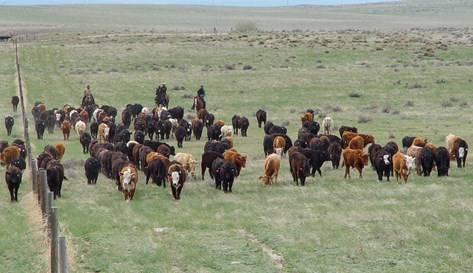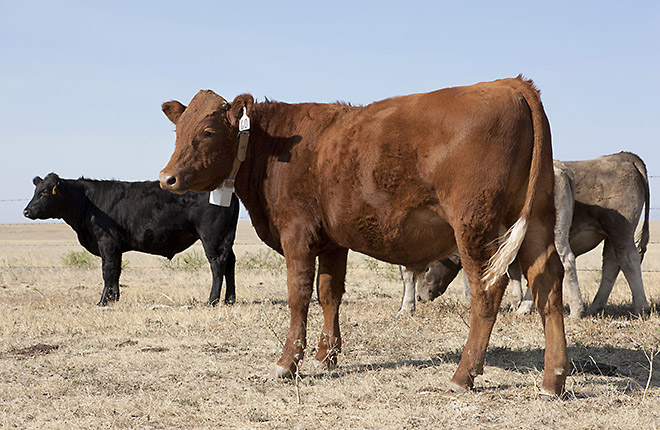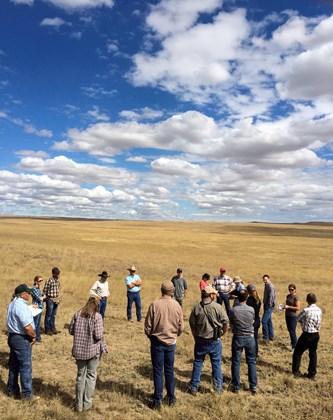Balancing Beef Production with Biodiversity
Justin Derner likens the Central Plains Experimental Range (CPER) in northeastern Colorado to a “living laboratory.” That’s because the 15,500-acre site near the town of Nunn, Colorado, affords a unique opportunity to conduct large-scale research addressing the diverse interests of cattle ranchers, conservationists, land managers, and other stakeholders. The CPER is one of 18 sites in the Agricultural Research Service’s (ARS) Long-Term Agro-Ecosystem Research (LTAR) network.
|
|
As research leader of the ARS Rangeland Resources and Systems Research Unit, in Cheyenne, Wyoming, Derner directs a multi-disciplinary team of scientists in both states. The team works to develop science-based approaches to maintaining the health and productivity of semi-arid rangeland areas in the Great Plains. The region, if outlined from space, might resemble a giant right footprint that extends from parts of Canada southward into 10 U.S. states, ending with the “heel” resting in Texas, New Mexico, and Mexico.
Getting Stakeholders Involved
In September 2012, Derner’s team hosted the first in a series of stakeholder workshops to chart a course of action in using the CPER to evaluate various livestock management and conservation practices. The 11-member stakeholder group—comprising cattle ranchers, wildlife conservation organizations, and public land managers—proceeded with a single overarching goal: To manage the land both ecologically and economically, so it can be passed on to future generations.
Towards that end, the group agreed upon three primary objectives:
- Increase density and distribution of cool-season grasses, such as western wheatgrass and needle-and-thread, and shrubs, such as fourwing saltbush and winterfat, to ensure that pastures have a variety of plants.
- Ensure profitability of ranching operations in the western Great Plains by maintaining or increasing cattle weight gains, minimizing the impact of drought, and reducing operating costs.
- Preserve or increase populations and habitat of native grassland birds, like mountain plover, which prefer areas of sparse vegetation, and grasshopper sparrows, which prefer areas with taller vegetation.
“We want stakeholders to be involved throughout the life of this project, as opposed to the traditional model of asking stakeholders for input at the beginning, conducting the research, and then publishing it for others to read,” says Derner.
Additionally, “Our whole research unit is involved in this LTAR project—researchers, technicians, data managers, and more than a dozen summer students,” adds Derner. “Rather than a traditional biophysical-based research project, we see this as a transdisciplinary process with emphasis on socio-ecological systems with human dimensions.” Several university, state, and federal partners are also involved.
Adaptive Grazing Management
Such diverse expertise enables collecting and monitoring data on the merits and trade-offs of a given strategy, such as “adaptive grazing management.” The term refers to a learning-driven approach to deciding where, when, and how best to graze herds and manage the land, based on desired economic and ecological outcomes.
 Cattle move to a new pasture. (Matt Mortenson, D3846-1) |
Using experimental pasture areas within the CPER, for example, the researchers are comparing traditional grazing methods to an adaptive management approach. The study design uses 10 paired, 320-acre pastures for each grazing strategy. In the adaptively managed strategy, a large herd of 244 yearling steers grazes a pasture until one of several triggers occurs (remaining vegetation, animal behavior, or maximum grazing days). At that point, the herd is moved to another pasture. This results in high stocking densities (244 animals per 320 acres), but longer periods of rest for the grazed pasture (1 year or more). In addition, the stakeholder group can decide to keep two pastures ungrazed for use as emergency forage in a drought year, if needed.
In traditionally managed pastures, 10 smaller herds (23-26 steers per 320 acres) graze a pasture for the entire grazing season, with no livestock rotation or pasture rest. Both grazing strategies have a moderate system-level stocking rate, but the adaptive strategy has a 10-fold greater stocking density (numbers of steers per pasture) than the traditional strategy.
Throughout the study, data are collected on cattle, vegetation, forage production, residue amounts, and grassland bird habitat. Researchers also monitor soil moisture, greenhouse gases, soil health, soil carbon and nitrogen, and carbon/water/energy balances.
Besides generating a wealth of long-term data, the LTAR project at this rangeland site has fostered an environment for learning, shared experience, and trust among the participants. “The project allows for a melding of different stakeholder information in a common experiment,” says Derner. “They’ve really made it their own.”
Making the Data Useful
The challenge now, Derner says, is to combine all that data into stakeholder-friendly formats, like “Story Maps,” a software application that presents large amounts of information as interactive visual displays. One upcoming effort is the planned spring 2018 release of “Grass Cast.” It’s the beta version of a computer simulation model that producers and land managers can use to predict the forage-production potential of a given pasture before moving a herd onto it to graze. Another project under way with the University of Colorado’s “Earth Lab” program is a visualization wall—a large video display system that will project a mosaic of high-resolution images of defined grazing areas, captured over time and space using remote-sensing technology blended with on-the-ground measurements.
Whether in the field or high in the sky, “the idea is to help our stakeholders make better decisions for the production and conservation outcomes they desire, as well as to reduce risks and increase sustainability of their operations,” says Derner.—By Jan Suszkiw, ARS Office of Communications.
------------------------------------------------------------------------------------------------------------------------------------
Central Plains Experimental Range, Nunn, Colorado
Crops Research Laboratory, Fort Collins, Colorado
High Plains Grasslands Research Station, Cheyenne, Wyoming
Bird Conservancy of the Rockies
Colorado State Land Board
Colorado State University
Environmental Defense Fund
Nature Conservancy
Texas A&M University
University of California-Davis
University of Wyoming
USDA, Forest Service
USDA, Natural Resources Conservation Service
Key Facts
- The ARS Central Plains Experimental Range is a 15,000-acre LTAR site in Colorado.
- Scientists there collect long-term data on different grazing strategies.
- Stakeholders participate in all phases of the research process.
- The research goal is to manage lands ecologically and economically.
Full Story









